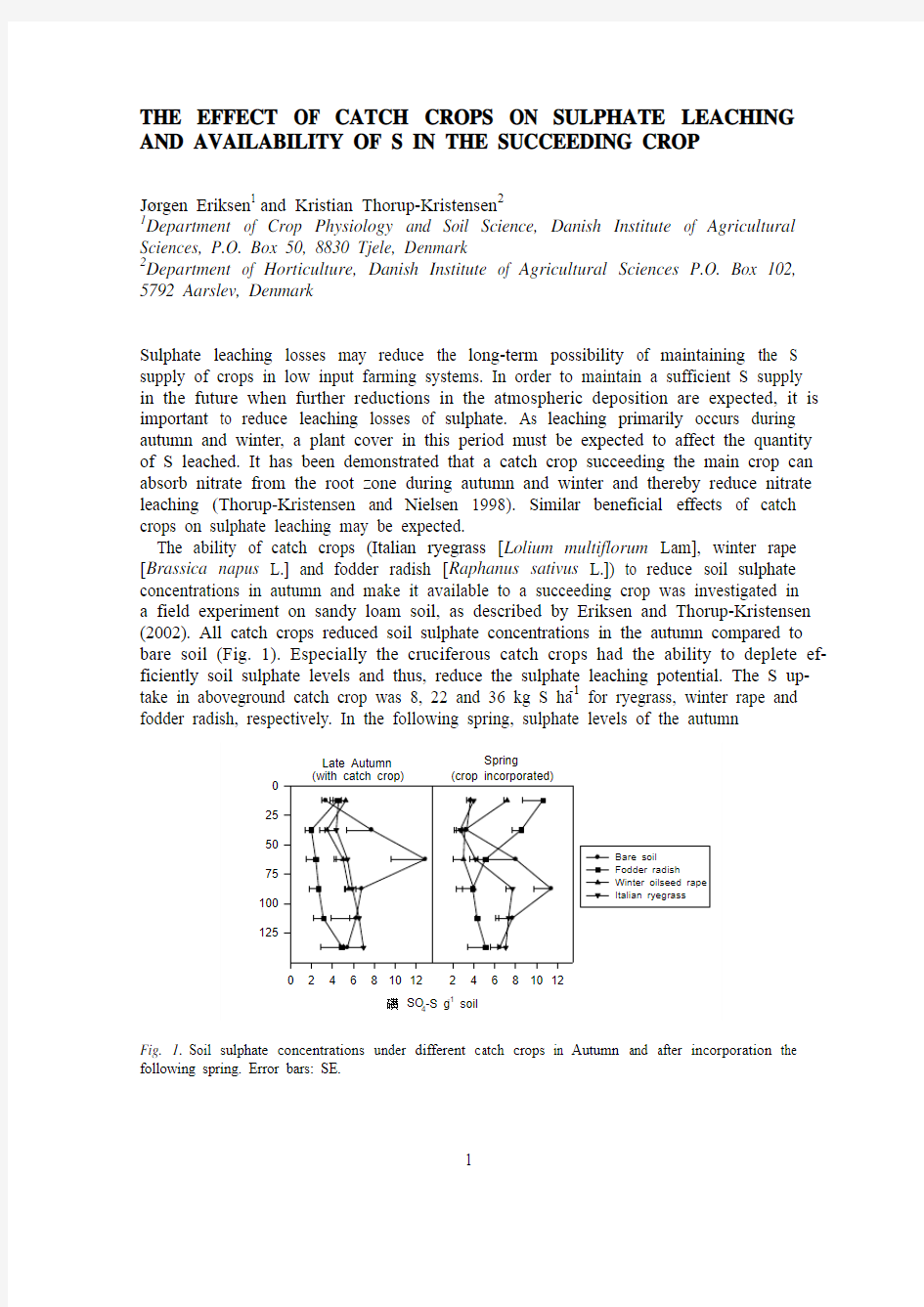The effect of catch crops on sulphate leaching and


THE EFFECT OF CATCH CROPS ON SULPHATE LEACHING AND AVAILABILITY OF S IN THE SUCCEEDING CROP
J?rgen Eriksen1 and Kristian Thorup-Kristensen2
1Department of Crop Physiology and Soil Science, Danish Institute of Agricultural Sciences, P.O. Box 50, 8830 Tjele, Denmark
2Department of Horticulture, Danish Institute of Agricultural Sciences P.O. Box 102, 5792 Aarslev, Denmark
Sulphate leaching losses may reduce the long-term possibility of maintaining the S supply of crops in low input farming systems. In order to maintain a sufficient S supply in the future when further reductions in the atmospheric deposition are expected, it is important to reduce leaching losses of sulphate. As leaching primarily occurs during autumn and winter, a plant cover in this period must be expected to affect the quantity of S leached. It has been demonstrated that a catch crop succeeding the main crop can absorb nitrate from the root zone during autumn and winter and thereby reduce nitrate leaching (Thorup-Kristensen and Nielsen 1998). Similar beneficial effects of catch crops on sulphate leaching may be expected.
The ability of catch crops (Italian ryegrass [Lolium multiflorum Lam], winter rape [Brassica napus L.] and fodder radish [Raphanus sativus L.]) to reduce soil sulphate concentrations in autumn and make it available to a succeeding crop was investigated in a field experiment on sandy loam soil, as described by Eriksen and Thorup-Kristensen (2002). All catch crops reduced soil sulphate concentrations in the autumn compared to bare soil (Fig. 1). Especially the cruciferous catch crops had the ability to deplete ef-ficiently soil sulphate levels and thus, reduce the sulphate leaching potential. The S up-
Fig. 1.the
1
2 Fig. 2. Mineralisation of catch crop S during the growing season of spring barley. Legumes are marked ‘*’. Inserted in bars are catch crop C/S ratios. Error bars: SE.
bare soil were low in the top 0.5 m and a peak of sulphate was found at 0.75-1 m depth (Fig. 1). In contrast, where a fodder radish catch crop had been grown, high sulphate levels were present in the top 0.5 m but only small amounts of sulphate were found at 0.5-1.5 m depth.
The release of S to barley (Hordeum vulgare L.) were investigated in pot experiments (setup described by Eriksen et al. 1995) after incorporation of the catch crops Cicho-rium intybus L., Medicago lupulina L., Anthyllis vulneraria L., Trifolium repens L., Pastinaca sativa L., Sanguisorba minor , Lupinus polyphyllos L., Lolium perenne L. and Raphanus sativus L. The S mineralisation rates were highest for cruciferous crops and lowest for legumes and differences were partly explained by the C/S-ratio (r 2=0,49) that varied from 48 to 265 (Fig. 2).
In the field, Eriksen and Askegaard (2000) found that sulphate leaching from an or-ganic dairy crop rotation, on sandy soil was 20 kg S ha -1 as average of 4 years or equivalent to 60 % of the total input. Sulphate leaching was very variable and ranged from 4 to 45 kg S ha -1 for the same crop in different years.
The catch crops showed a great potential for reducing sulphate leaching. Especially cruciferous crops, having a high S-demand and vigorous root growth efficiently dep-leted the soil sulphate pool. In a crop rotation, including both low-S-demanding cereals and high-S-demanding main crops a suitable catch crop strategy may prevent excess sulphate from leaching in years with low-S-demanding crops and instead transfer S to the following high-S-demanding crop. This is most important in low input systems, e.g., organic farming, but also of relevance to other farming systems.
References
Eriksen, J. & Askegaard, M. 2000. Agric. Ecosyst. Environ. 78: 107-114.
Eriksen, J. & Thorup-Kristensen, K. 2002. Agric. Ecosys. & Environ. 90: 247-254.
Eriksen, J., Mortensen, J.V., Dissing Nielsen, J. & Nielsen, N.E. 1995. Agric. Ecosys. & Environ. 56: 43-51.
Thorup-Kristensen, K. & Nielsen, N.E. 1998. Plant Soil 203: 79-89.
Mineralisation (% of added)
020*********
Lupine *Kidney vetch *
White clover *
Chichory
Ryegrass
Black medic *
Salad Burnet
Parsnip
Fodder radish
